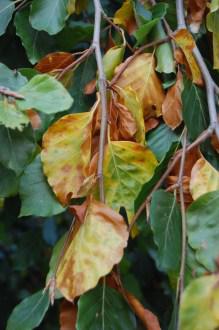
Fagus sylvatica pendula autumn leaf (01/11/2011, London)
Position: Full sun to partial shade
Flowering period: Spring
Soil: Well drained
Eventual Height: 15m
Eventual Spread: 20m
Hardiness: USDA Zones 5a – 9b
Family: Fagaceae
Fagus sylvatica ‘Pendula’ is a deciduous tree, with a weeping growth habit, with the branch tips often touching the ground. The mid to dark green leaves are broad, flat, simple and not lobed. They have smooth margins and are alternate and typically measure 5 – 10 cm in length. The leaves turn a copper color in the autumn. The stem of this tree is often covered by the hanging branches of this tree, however, the bark of the tree has a silvery colour, and is smooth. The flowers appear in spring and are inconspicuous, and are followed by the usually spiny fruits, beechnuts, which sit in a thin spiny husk and are less than 5 centimeters in diameter.
F. sylvatica ‘Pendula’, commonly known as the Weeping Beech, is a cultured variety of the deciduous European Beech. Weeping beeches may live for 150 to 200 years. This tree has been in existence in England since 1836 and many later varieties derived from it.
The etymological root of the binomial name Fagus is the old Latin name for the Beech tree, some scholars believe it to be derived from the Greek phago meaning ‘to eat’, as the nuts were a historic source of food. The term Sylvatica is derived from the Latin meaning ‘of the woods’. Pendula is derived from the Latin meaning ‘hanging’

Fagus sylvatica pendula (01/11/2011, London)
The landscape architect may find Fagus sylvatica ‘Pendula’ useful as a specimen tree or a focal point in a parkland setting, it does need space to be fully appreciated.
Ecologically, leaves of this tree are food for numerous caterpillars .
F. sylvatica ‘Pendula’ was awarded the prestigious Royal Horticultural Societies annual Award of Garden Merit in 1993.
F. sylvatica ‘Pendula’ prefers a humus rich, fertile well drained soil. It prefers soils of a neutral to alkali soil pH.
Maintenance: This tree requires little maintenance. Lower hanging branches may be removed to provide room under the canopy.

